
English Apples - Apple Breeding
Grower: 'Suttonelms' (England). New information on all of the seedlings is posted at the TOP of this page. From time to time I sort it out into separate years to follow the progress of particular seedlings.
Suttonelms breeding ...Seedlings from
2010.
2011.
2012.
2013.
UPDATE, 24 Feb 2014
2011 crosses: The most suitable seven of these have now been grafted: two trees of each, and six of them have also been added to an existing tree to facilitate their early fruiting. Picture below.

UPDATE, 8 Jul 2013
2013 crosses:
One of our recent crosses, Laxton's Fortune x Bieinrode. The right hand apple has been pollinated using redfleshed Bieinrode pollen. It has no calyx since this is removed during the process. The other one has been pollinated in the normal way so its seeds will be of no interest.
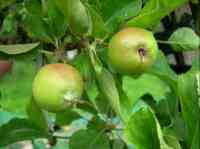
UPDATE, 21 May 2013
2011 crosses:
First picture: Allens Everlasting x Bieinrode; two vigorous redleaved seedlings; two greenleaved seedlings, one of them very small; second picture: Wyken Pippin x Bieinrode; one vigorous redleaved seedling; three other much smaller plants; third picture: Procrastinator x Mott's Pink. All of these are crosses of very late-keeping English apples with redfleshed pollen. Powdery mildew in the third picture, often seen in young seedlings under damp conditions.
POLLENS
For those who are interested - this is what apple pollen looks like. The anthers are combed off into a plastic tray and come in various colours - pale yellow to pink, depending on the variety. After 24 hours exposure to a warm room, pollen (a yellow powder in the case of apples) appears on the surface, which rubs off. This can be seen in the three pictures below.

HOW DO I RECOGNIZE A HAND POLLINATED APPLE?
If you remove the calyx during hand pollination, the resulting apples look like this (click for detail):
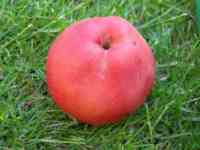
It is therefore easy to pick out those apples where both the seed and pollen-parent are known. This apple is Webster Pinkmeat, a pink-fleshed variety.
UPDATE, 10 May 2013
2010 crosses: Laxton's Fortune x Almata: grafted in Feb and now growing well, grafted onto MM106.

UPDATE, 8 May 2013
2012 crosses: Something unexpected - last year I did a lot of pollenations with Scarlet Surprise pollen and had no success, so assumed it was triploid. On sorting through my last stored apples from 2012, I have found two hand-pollinated Croft Late apples, and on looking through my records, they were pollinated with Scarlet Surprise.
I consulted a biologist who told me that a very tiny fraction of pollinations with triploid pollen would be viable, but that the resulting plants, although they might produce apples, would be unlikely to set seeds. Some book work is necessary on my part. However, the simplest explanation would be that Scarlet Surprise is not triploid.
Anyone know anything about Scarlet Surprise?
Secondly, two of the three Langton Nonesuch x Huonville Crab crosses are showing signs of red pigmentation; the veins in the leaves are turning red. The third has perfectly green leaves at the time of writing.
UPDATE, 6 Apr 2013
2012 crosses:

The green-leaved seedlings in the background are open-pollinated Pink Pearl, so far showing no sign of redfleshed parentage. Pink Pearl itself has green leaves. The red-leaved plant in the foreground is a Breunsdorf open-pollinated seedling. These are usually green-leaved so this one is unusual.
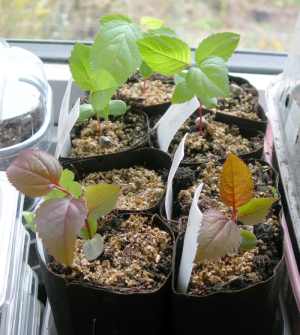
In the background with green leaves are seedlings of Langton's Nonesuch x Huonville Crab; so far with no sign of redfleshed parentage. In the foreground is Burford Sour, a late striped crab/domestic apple cross with a sour-astringent, very strong flavour, crossed with George's Red, a pink-fleshed apple with a good flavour reasonably similar to that of Devonshire Quarrenden. Usually George's Red produces green leaved seedlings, so this one is unusual.
UPDATE, 5 Apr 2013
2011 crosses: best 20 seedlings, selected for vigour, health and interesting features ... another dozen or so will be thrown away during the next 12 months and the most promising (the remainder) will be grafted next year and grown until they fruit.

UPDATE, 19 Feb 2013
2010 crosses: Grafting of seedlings: (see picture 5 Apr 2012)
Laxton's Fortune x Almata
1. Reddish leaved seedling, vigorous: pale pink scion wood. 3 trees grafted.
2. Less vigorous seedling with less leaf pigmentation: scion wood uncoloured. 3 trees grafted.
3. Least vigorous seedling with no leaf pigmentation: scion wood deep crimson. 3 trees grafted.

These seedlings look interesting; a real mix-up of Laxton and Almata redfleshed genes. The picture shows the scions of the three seedlings; from left to right: numbers 3,2,1; note the coloured wood.
D'arcy Spice x Mott's Pink
1: green leaved seedling, most vigorous, uncoloured scion wood: 2 trees grafted.
2: green leaved seedling, less vigorous, uncoloured scion wood: 2 trees grafted.
3: green leaved seedling, least vigorous, uncoloured scion wood: 2 trees grafted.
These seedlings have no trace of pigmentation.
Whitwick Pippin x George's Red
1. One seedling only, extremely vigorous, green leaved. 2 trees grafted.
No obvious pigmentation, but may have unusual properties: Whitwick Pippin is extremely late fruiting and mainly red skinned; George's Red is redfleshed.
24 Mar 13 - grafting completed
UPDATE, 20 Jan 2013
2012 crosses: Seed extraction from the hand pollinated apples gave very few seeds indeed; however we have a few Langton's Nonesuch x Huonville Crab, which must be a first, anywhere. It will be interesting to see if they grow.
Readers may remember that Langton's Nonesuch originated in Church Langton, Leicestershire, became extinct in England in the 1920s, but a tree was rediscovered in a garden in Germany and brought back to England by Leicestershire Heritage Apples Project (us) in 2008.
UPDATE, 25 Nov 2012: Autumn Pictures
Two 2011 crosses: Wyken Pippin x Bieinrode and Allens Everlasting x Bieinrode. The red colouration in the leaves becomes more pronounced in the autumn.
 ....
....

UPDATE, 25 Aug 2012
2010 crosses:
Ribston (triploid) x Mott's Pink - had been attacked by woolly aphis, no growth for 2 months, puny specimen - discarded.
Two more D'Arcy Spice x Mott's Pink had scabby green leaves covered in brown patches; weak growth - discarded.
So from 2010 there are seven remaining healthy seedlings: three Laxton x Almata (leaf colours green, red tinted green and slightly stronger red-green), three D'Arcy Spice x Mott's Pink (green leaved) and one Whitwick Pippin x George's red (green leaved). These will be grafted and trialled starting next year.
2011 crosses:
MM106 x Bieinrode seeds from 2011 did not germinate. Possibly an incompatible cross.
Allens Everlasting x Bieinrode: two green leaved seedlings of low vigour discarded. Three seedlings remain; two vigorous red leaved plants and one green leaved with less growth.
Wyken Pippin x Bieinrode: 4 seedlings remain; one is very vigorous and red leaved. Of the other three, one is small and red leaved; the others small and green leaved:

Procrastinator x Mott's Pink: 2 seedlings, both green leaved; fairly vigorous but leaves showing sign of attack by scab.
Croft Late x George's Red: 2 seedlings, low vigour; both with no pigmentation and the leaves showing attack by scab.
OPEN POLLINATED
2011 crosses, open pollinated, retained: (those with red leaves, unusual vigour or other feature worthy of note)
One very vigorous dark red leaved seedling of unknown parentage, one Hidden Rose seedling, red leaved, very vigorous, one Spenser Seedless with red leaves which somehow seems to have been pollinated by a red fleshed plant (odd since Spenser Seedless does not attract pollinating insects - the flowers have no petals), and two red leaved Weirouge seedlings which appear healthy. Also one Pink Pearl seedling, very small but healthy and with tiny red leaves.
Other seedlings (about a hundred) were discarded.
Other observations from 2012
1.Scarlet Surprise produced no seedlings at all when used as a pollinator. Open pollinated seeds from Scarlet Surprise showed a poor germination rate and the seedlings were very weak and unhealthy. This suggests Scarlet Surprise may be triploid and probably best avoided in future work.
2.Purple radish seeds, open pollinated, produced mainly green leaved seedlings but a few red leaved. The seedlings were mainly healthy.
3.Bieinrode open pollinated produced about 40% red leaved seedlings, mainly healthy.
4.Pink Pearmain seedlings, open pollinated, produced green leaved seedlings only. They were susceptible to scab / brown patches on leaves; most were of low vigour.
5.All Wyken Pippin x Bieinrode seedlings were healthy; roughly 50:50 red leaved : green leaved.
6.Burford Redflesh is a viable pollinator but it is poor.
7.George's Red was again found to be a good pollinator but the seedlings show little sign of pigmentation.
8.Bieinrode is a good pollinator and will be worth using in future work. However it is small so it is likely to reduce fruit size in the resulting trees.
UPDATE, 15 Jun 2012
2011 crosses; Allens Everlasting x Bieinrode growing rapidly (below):
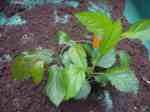 ...
...
UPDATE, 6 Jun 2012
2010 crosses: D'Arcy Spice x Mott's Pink: Two of the six seedlings are very susceptible to mites (below). This is after daily spraying with an insecticide for a fortnight. The insects are gone but the leaves have not recovered. These have been discarded.

The other Darcy Spice x Mott's Pink seem OK; all are green leaved (below).

The three Laxton x Almata are growing well and should be graftable next year (below). The older leaves are greener than when they first appeared but the red pigmentation can be seen in two of them (click for detail).
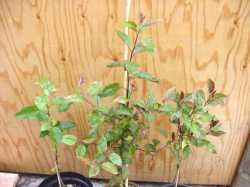 ...
...
Whitwick Pippin x George's Red seems vigorous, and green leaved. Ribston (triploid) x Mott's Pink is growing very slowly but apart from that seems healthy enough.
2011 crosses; about a dozen seedlings growing. All green leaved so far. Photos:
Allens Everlasting x Bieinrode (below):
 ...
... ...
...
2011 open-pollinated: Weirouge germinates very easily and about a third of the seedlings are red leaved. Hidden Rose pips so far have produced mainly green leaved seedlings with an occasional red leaved variant (below).
 ...
...
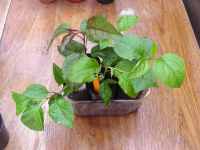 ...
...
Breunsdorfer also germinates very easily and so far has given green leaved seedlings only (left, below). Bieinrode has given about 50% red leaved seedlings (right, below).
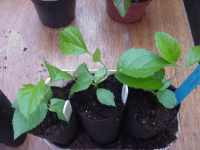 ...
...
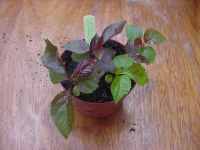 ..
..
UPDATE, 14 May 2012
2011 crosses: More seeds are starting to germinate: Allens Everlasting x Bieinrode and Wyken Pippin x Bieinrode.
UPDATE, 12 May 2012
2012 crosses: Very little sign of any 'take' with the Scarlet Surprise pollen. I wonder if it's triploid. One or two of the Burford's Redflesh crosses look as if they have worked.
UPDATE, 29 Apr 2012
2010 crosses: Picture of a D'Arcy Spice x Mott's Pink seedling from last year. These seem to have little or no red pigmentation.

UPDATE, 26 Apr 2012 and 12 May 2012
2012 crosses: mainly darker coloured(*) redfleshed varieties crossed with a range of English apples:
Laxton's Fortune x Scarlet Surprise* UPDATE - NO FRUIT SET
Laxton's Fortune x Burford's Redflesh* UPDATE - NO FRUIT SET
Devonshire Quarrenden x Scarlet Surprise* UPDATE - NO FRUIT SET
Devonshire Quarrenden x Burford's Redflesh* UPDATE - NO FRUIT SET
Burford Sour (a domestic/crab hybrid, judging by its size and flavour) x George's Red - successful
Croft Cider x Scarlet Surprise* UPDATE - NO FRUIT SET
Claygate Pearmain (triploid) x Scarlet Surprise* UPDATE - NO FRUIT SET
Huonville Crab* x Scarlet Surprise* (both red fleshed) UPDATE - NO FRUIT SET
Golden Noble x Burford's Redflesh* UPDATE - NO FRUIT SET
Merton Knave x Burford's Redflesh* UPDATE - NO FRUIT SET
Langton's Nonesuch x Huonville Crab* - successful
West Virginia Sweet x Scarlet Surprise* UPDATE - NO FRUIT SET
Pink Pearmain x Scarlet Surprise* UPDATE - NO FRUIT SET
Blackjack x Burford's Redflesh* - successful
comment - the appalling weather during the pollination period has affected fruit set for the hand pollinations. Then most of the hand pollinated apples fell off during the 'June Drop'.
UPDATE, 20 Apr 2012
2011 crosses: Burford Red (aka Procrastinator) x Mott's Pink - seeds from last year are germinating.
UPDATE, 5 Apr 2012
2010 crosses: LAXTON x ALMATA second year; first leaves on the three seedlings shown below. These should produce interesting fruit. Laxton's Fortune is one of the best flavoured English apples, and Almata is one of the most vividly coloured redfleshed varieties.

Green leaves with pink margins; darker, and much darker....
UPDATE, 1 Apr 2012
NEWS ON SEEDLINGS
Hand Pollinated:
2011 crosses: Croft Late x George's Red has produced two seedlings; green leaved; no sign of any pigmentation. (below)

2011 Open-pollinated redfleshed pips have given, so far:
WEIROUGE - mainly green leaved seedlings but one red leaved (pic below).
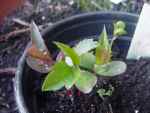
HIDDEN ROSE -nearly all are green leaved seedlings but one red leaved. (below)
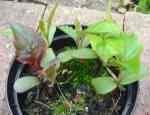
PINK PEARMAIN -all green leaved.
SCARLET SURPRISE - one seedling, red leaved; does not look very healthy.
UPDATE 1 Jun 2011
Another hand pollinated Croft Late x George's Red from last season found; apple beginning to show signs of rot. Seeds extracted and sowed immediately into fine soil, indoors, covered container.
Also have two open pollinated Hidden Rose seedlings just showing, and one open pollinated Burford Yellow seedling.
UPDATE, 30 May 2011
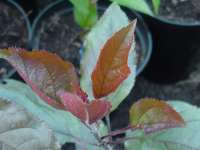 ....
....
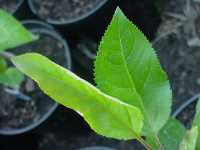
Showing leaf differences in two Laxton x Almata seedlings, the seeds taken from the same apple. Click on the pictures for the detail.
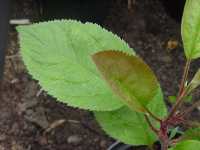 ....
....
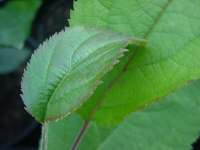
Similar pictures for Whitwick Pippin x George's Red and a Darcy Spice x Mott's Pink. To some degree they all show hints of red-fleshed parentage.
Meanwhile a few more apples are resulting from crosses done this year:
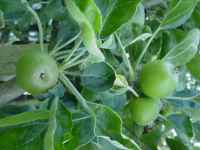 ....
....
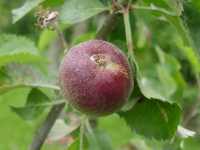
-these are Wyken Pippin x Bieinrode and Allens Everlasting x Bieinrode. Malus Bieinrode is a red fleshed apple with deeply pigmented flesh, slow growing, found near Bieinrode, West Germany, a few years ago.

D'Arcy Spice x Mott's Pink, all looking healthy.

Laxton x Almata (first three plants) and Ribston x Mott's Pink (on right), 30 May. The individual differences between the plants are becoming more apparent.
On re-potting, the red-tinted seedlings were found to have bright pink tips to the roots. The roots of the others were perfectly white. Click on the small picture to see this.
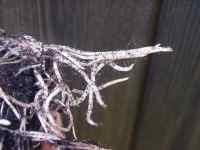
UPDATE, 1 May 2011
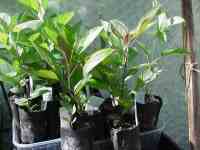
Mott's Pink crosses (D'Arcy Spice x MP and Ribston x MP).
The Ribston seedling (Ribston is triploid) is smaller and weaker than the others though this cannot be seen from the picture.
UPDATE, March 2011
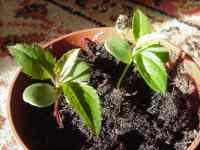 .....
.....
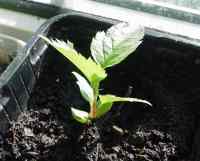 .....
.....
Laxton x Almata; and Ribston x Mott's Pink.
ND / Diversity website


